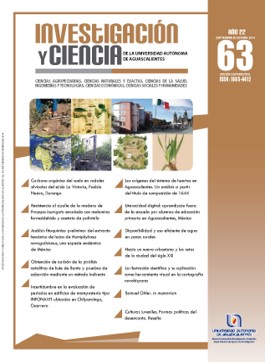Carbon from waste tire rubber through catalytic pyrolysis and adsorption probes by an indirect method
DOI:
https://doi.org/10.33064/iycuaa2014633608Keywords:
coal, catalytic pyrolysis, waste tire rubber, catalyst HZSM-5Abstract
In this work the results obtained from the catalytic pyrolysis of waste tire rubber are presented, discussed and compared with thermal pyrolysis. The catalyst used was prepared by blending method from a mixture of HZSM-5 zeolite and γ-alumina. The pyrolisis process was performed at 450 °C in N2 flow for 30 min, 60 min and 120 min of reaction in order to obtain carbon.
Carbons obtained were characterized by textural and infrared spectroscopy analysis and tested in an adsorption process applying an indirect method. This process was used to demonstrate its ability to remove contaminants, such as methylene blue and acid blue
25, and to compare the adsorption capacity with a commercial carbon.
Downloads
References
• FERNÁNDEZ, R. et al. Characterization of the Powder Obtained from Wasted Tires Reduced by Pyrolysis and Thermal Shock Process. J. Applied Research and Technology, 6(2): 95-105, 2008.
• HASEGAWA, G. et al. Fabrication of Activated Carbons with Well-defined Macropores Derived from Sulfonated Poly(divinylbenzene) Networks. Carbon, 48, 1757-1766, 2010.
• JANG, J. W. et al. Discarded Tire Recycling Practices in the United States, Japan and Korea Resources. Conservation and Recycling, 22, 1-14, 1998.
• LABUS, K. et al. Granular KOH-activated Carbons from Coalbased Cokes and their CO2 Adsorption Capacity. Fuel, 118, 9-15, 2014.
• LEE, J. S. y KIM, S. D. Gasification Kinetics of Waste Tire-char with CO2 in a Thermo-balance Reactor. Energy, 21, 343-352, 1996.
• LEUNG, D. Y. C. et al. Pyrolysis of Tire Powder: Influence of Operation Variables on the Composition and Yields of Gaseous Product. Fuel Processing Technology, 79, 141-155, 2002.
• LI, L. y SHUANGXI, L. Application of Activated Carbon Derived from Scrap Tire for Adsorption of Rhodamine B. Journal of Environmental Sciences, 8, 1273-1280, 2010.
• OLAZAR, M. et al. Catalyst effect on the composition of tire pyrolysis products. Energy & Fuels, 22, 2909-2916, 2008.
• PAKDEL, H. et al. Production of Dl-limonene by Vacuum Pyrolysis of Used Tires. J. Analytical Applied Pyrolysis, 57, 91-107, 2001.
• TROCA, C. et al. Development of Adsorbents from Used Tire Rubber: Their Use in the Adsorption of Organic and Inorganic Solutes in Aqueous Solution. Fuel Processing Technology, 92, 206-212, 2011.
• UNAPUMNUK, K. et al. Carbon Distribution from the Pyrolysis Tire-Derived Fuels. lndustrial Engineering Chemistry Research, 45: 8757-8764, 2006.
• WEI, Q. et al. Pyrolysis of Waste Tire on ZSM-5 Zeolite with Enhanced Catalytic Activities. Polymer Degradation and Stability, 91, 2389-2395, 2006.
• WILLIAMS, P. T. y BRINDLE, A. J. Aromatic Chemicals from the Catalytic Pyrolysis of Scrap Tyres. J. Analytical Applied Pyrolysis, 67, 143-164, 2003.
• YATES, M. et al. (2002). Técnicas de análisis y caracterización de materiales. Madrid, España: Consejo Superior de Investigaciones Científicas-CSIC, 221 pp., 2002.
• ZABANIOTOU, A. A. y STAVROPOULOS, G. Pyrolysis of Used Automobile Tires and Residual Char Utilization. J. Analytical Applied Pyrolysis, 70, 711-722, 2003
Downloads
Published
How to Cite
License
Copyright (c) 2014 Jorge Medina Valtierra, María Marisol Guerrero Esparza

This work is licensed under a Creative Commons Attribution-NonCommercial-ShareAlike 4.0 International License.
Las obras publicadas en versión electrónica de la revista están bajo la licencia Creative Commons Atribución-NoComercial-CompartirIgual 4.0 Internacional (CC BY-NC-SA 4.0)









